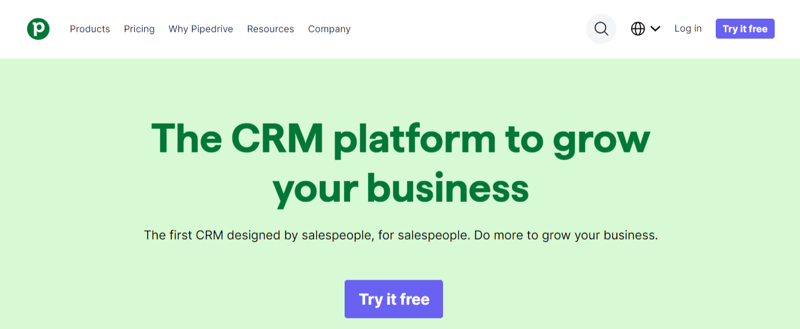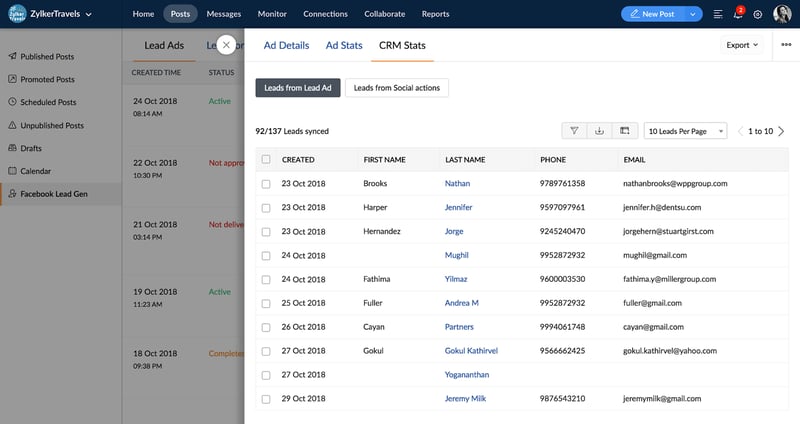
How Successful Businesses Make the Most of Their Lead Generation Software
 Updated on
Updated on
 By Robins Dorvil
By Robins Dorvil
Robins Dorvil
With over 7 years of experience in the insurance industry, 4+ years as an Account Executive at Ringy CRM, and 17 years as a Creative Real Estate Inves...
learn more
Robins Dorvil
With over 7 years of experience in the insurance industry, 4+ years as an Account Executive at Ringy CRM, and 17 years as a Creative Real Estate Inves...
Table of Contents
Table of Contents
Lead generation is more of a priority for businesses than ever before.
But, without knowing how to use lead generation tools, you might find yourself resorting to desperate measures to attract people to your business.
Having the right lead generation software – and knowing how to use it – can be a game-changer. It can help you:
- Attract more high-quality leads
- Organize them so you never lose track
- Qualify and score them
- Move them safely through your sales funnel
- Make more money
Ready to find out how to do it? Here's how successful businesses make the most of their lead generation software.
Introduction to Lead Generation Software
What is lead generation?
Bear with us while we run through the basics of lead generation software.
A lead is any person who has the potential to become a paying customer. Lead generation, therefore, is the process by which you manage that transformation – pretty simple, right?
It generally falls into two categories:
- Outbound lead generation: This encapsulates activities like cold calls, direct emails, and outreach events.
- Inbound lead generation: Anything that encourages your leads to come to you. This means SEO, landing pages for offers, social media, content marketing – even a helpful blog post…
It's generally agreed that inbound lead generation is the most effective, and it's easy to see why. When somebody arrives in your funnel of their own accord, for instance by signing up to your newsletter or completing a contact form, it usually means that they're already interested in what you do. That's one of your big jobs already done.
In fact, content marketing has been shown to be three times more effective than outbound lead generation methods, while costing 62% less.
All this makes the answer to our next question pretty obvious.
What is lead generation software?
Any software that helps you automate the process of lead generation. It's that simple.
Lead generation software might integrate with your existing customer relationship management system, or CRM (hint: we think this is your best option). Or, it might be a separate system that you use alongside your CRM.
We'll get into specific features and software types below, but generally speaking, when it comes to your outbound lead generation efforts, lead generation software helps you:
- Store contact information
- Generate a call list
- Stay on track when moving prospects through the pipeline
- Track your interactions with each lead
For your inbound lead generation, it might:
- Scrape your web forms to generate a lead profile
- Help you manage your email marketing to qualify leads
- Schedule and monitor social posts and ads
It can make a huge difference. 80% of marketers that used automation software saw an increase in leads, with 77% also reporting an increase in conversions.
So, what sales lead generation software is out there?
5 Top Lead Generation Software
1. Ringy

We'll spare you the false modesty: we think we're pretty great!
Ringy is an all-in-one sales solution with a user-friendly interface, proven to increase sales.
It's great value at just $109 per month after a one-month free trial, with add-ons depending on your usage of our cloud calling features.
We offer all the most important features in lead generation software:
- An all-in-one CRM solution
- Lead Management
- Lead Distribution
- Campaigns
- Sales Pipeline
- SMS and Email Drip Automation
- Reports + Analytics
- Cloud calling
- Click-To-Call Dialing
- Call Recording
- Local Caller ID
- Agent Coaching
But don't just take our word for it. Listen to what our customers had to say:
*Pricing as of March 2025
2. Zoho CRM

Zoho One is another giant of the lead generation CRM space.
As we've already mentioned, it's highly customizable to your industry due to the suite of Zoho One integrations, which include general-purpose apps like WhatsApp and Gmail, but also more specialized apps, such as QuoteWerks, Leadfeeder, and ActiveCampaign.
Zoho also scales more reasonably than some software when it comes to pricing:
|
Pricing tiers |
Zoho |
|
Standard |
$12/user/month, billed annually |
|
Professional |
$20/user/month, billed annually |
|
Enterprise |
$35/user/month, billed annually |
|
Ultimate |
$45/user/month, billed annually |
However, it has a high setup cost as you need a Zoho partner to install it and fit it to your business requirements. CRM development projects like this can cost anywhere between $6,000 and $24,000 for the average business.
*Pricing as of March 2025
3. Salesforce

Salesforce is another popular CRM software that offers industry-specific tools and, as you'd expect from its name, focuses heavily on sales.
Salesforce offers multi-device support so that you can operate your business and sales team on the go, as well as central document storage, making file access and file sharing easy with both teams and clients.
The key attraction of Salesforce is its sales focus and its affordability: it starts at just $27.07 per user per month, making it a popular choice for small businesses.
*Pricing as of March 2025
4. HubSpot

As we've already covered, HubSpot is one of the most famous lead generation software solutions on the market. They coined the term "inbound marketing", and offer a free version of their sales CRM.
However, as we've seen already, HubSpot skyrockets in price once you move up from the free version.
If you're willing to pay a premium, you can access advanced features like:
- AI-powered call intelligence to automatically note key points from meetings
- Document tracking to see which documents help to close deals
- Email templates for high-performing emails, which can be customized with information directly from the CRM
Their Marketing Hub pricing plans start at $15/mo/seat and go as high as $800/mo for their Professional suite, which includes 3 seats.
*Pricing as of March 2025
5. Pipedrive

Pipedrive is a sales-focused CRM platform designed to help businesses streamline their sales processes and enhance lead generation efforts. Its intuitive interface and robust features make it a popular choice for sales teams aiming to improve efficiency and close deals more effectively.
Key Features:
- An optional LeadBooster Add-on that includes chatbot, live chat, prospector, which accesses a database of 400+ million profiles and 10 million companies, and webforms.
- A centralized leads inbox to store and manage incoming leads before they enter the sales pipeline, allowing for better organization and prioritization.
- You also get smart contact data that imports valuable information from the web with a single click, using contacts' email addresses to collect publicly shared data, aiding in lead scoring and segmentation.
- Distributes new leads and deals to specific teams or team members based on predefined rules.
- Provides real-time AI insights and suggests the next best actions, helping sales reps prioritize tasks and focus on high-potential leads.
The LeadBooster add-on is available for an additional $32.50 per month per company when billed annually, or $39 per month when billed monthly. This add-on can be integrated with any Pipedrive CRM plan.
As for the CRM plans, Pipedrive offers subscription plans starting from $14 per seat per month, billed annually.
*Pricing as of March 2025
Types of Lead Generation Software
First of all, there's no one "type" of lead generation software.
Every business is different and will have different needs. The type of lead generation software you'll need in an insurance agency will be different if you're trying to get leads for a car dealership, for example.
Let's have a look at a bunch of different lead generation tools.
|
Type of Lead Generation Software |
Purpose |
|
Lead Generation CRM |
Centralized system for managing leads and customer interactions |
|
Lead Nurturing Software |
Engages and nurtures potential leads through various stages |
|
B2B Lead Generation Software |
Helps businesses generate leads from other businesses |
|
B2C Lead Generation Software |
Designed to capture leads from individual consumers |
|
Automated Lead Generation Software |
Uses AI and automation to streamline lead generation |
|
Call Tracking Software for Lead Generation |
Tracks and analyzes inbound calls to improve conversion rates |
|
Sales Lead Generation Software |
Helps sales teams find and convert high-quality leads |
|
Email Lead Generation Software |
Uses email marketing strategies to capture and nurture leads |
Lead Generation CRM
This is the big one you'll have heard about if you've done even a casual Google search of sales lead generation software.
A CRM system is a software that allows you to centrally store and manage all of your lead and customer data. Standard CRM features usually include:
- Contact management
- Email integration
- Workflow automation
- Document management
- Pipeline management
Obviously, all of these are useful tools to have if you're trying to generate leads. But a really great CRM will also have specialized lead generation tools, like lead distribution features, lead management, and lead scoring, as well as the other types of lead generation software listed below.
For instance, this is what Facebook lead generation management looks like in Zoho CRM.

In case you couldn't tell already: we think lead generation software that's integrated within your CRM is the best solution. The fewer systems you have to navigate, the more information you have about your business, and the less likely a lead is to fall in between the cracks.
Lead Nurturing Software
We know, we know. "Lead nurturing" sounds pretty touchy-feely.
But really, it's all about educating your lead about why it's worth paying for your product or service, at every stage of their relationship with your company.
A key way you'll do this is through drip campaigns. Sounds gross, but it just means feeding a little bit of information to your customers at key points – look out for more on this below.
Lead generation software will let you automate this process so that it doesn't take time out of your sales reps' day, freeing them up to use the other tools on this list to bring in even more clients to your business.
B2B Lead Generation Software
One of the biggest factors in the kind of lead generation software your business will use will be whether you're selling to individual consumers or other businesses.
|
B2C selling |
B2B selling |
|
Every individual is a potential customer with buying power |
Only business decision-makers have the power to purchase |
|
The average customer may not be highly informed about their purchase |
The target customer is well-informed |
|
Purchase is usually motivated by price perception and quality |
Purchase often motivated by trust and a personal relationship with salespeople |
|
Usually smaller amounts of money |
Large amounts of money |
|
Simple contracts |
Complex contracts |
|
Short sales cycle |
Longer sales cycle, sometimes taking months or even years |
The most important features you'll be looking for in a B2B lead generation software solution are:
- Webform optimization: Almost half of the marketers say that their web forms are their highest-converting lead generation tool, so it pays to have these up to scratch. A lead generation CRM will help you do that.
- Data mining: Scraping industry directories to populate your CRM with relevant information about your contacts.
- Lead distribution: Directing leads to the correct salespeople based on the information you have about them.
- Contact management: Centralizing all of this data into one dashboard so that every time you interact with a lead, you have all the information you need right in front of you.
B2C Lead Generation Software

Choosing B2C lead generation software might be a little different.
You'll probably be looking for a lot of the features we've already mentioned, but you'll also want to focus more heavily on inbound and lead nurturing features, for instance:
- Social media ad management
- SERP ad management
- Drip marketing
- Landing page optimization
Automated Lead Generation Software
All of the software we're talking about here are examples of automated lead generation software. However, specific examples of tasks that your lead generation software should take off your hands include:
- Email marketing
- Contact center management and lead distribution
- Call scheduling and call lists
- Chatbots and customer queries
This sounds like a lot, but it pays to invest in automation: high-growth firms are 26.2% more likely to have a highly-mature automation strategy in place compared to their lower-growth counterparts.
Call Tracking Software for Lead Generation
![]()
Sophisticated call tracking software for lead generation will be able to tell you which marketing source your call leads are coming from – for instance, if they're finding you on Google or from a Facebook ad.
A popular way of achieving this is through Dynamic Number Insertion (DNI), which is when your call tracking software automatically assigns a different phone number to different lead generation sources. A LinkedIn ad would show a different number to your website's homepage, and so on.
This allows you to see where your calls are coming from, but any good CRM will also offer other call features like:
- Call transcription
- Keyword call tracking
- Call whisper, in which an automated voice tells the salesperson where the call has come from before they pick up
- Call flows, which allow the caller to direct their query to the right place by dialing numbers on their keypad
- Contact management
Sales Lead Generation Software
Mostly, we've dealt with how to generate leads from the information you already have. But sometimes, you're going to need to step outside your existing lists and find new potential customers.
There are many lead generation software tools out there to help you find new contacts that don't require you to buy a stack of ice-cold leads.
Here are some examples:
|
Sales lead generation software |
Purpose |
|
Hunter.io |
Finds the email address pattern for any domain you type in |
|
AeroLeads |
A Google Chrome extension to help you scrape sites like LinkedIn to find out who to contact |
|
Discover.ly |
Augments visible data from social media sites like LinkedIn with additional info, for instance, email addresses |
Email Lead Generation Software
Emails are one of the ripest areas for automation when it comes to sales.
You're probably using some form of email lead generation software already – perhaps Mailchimp to manage your regularly-scheduled newsletters and send them to tailored audiences.
If this is the case, you're already off to a good start. Marketers who segment their email lists have been shown to get 39% higher open rates and 28% lower unsubscribe rates to their emails.
Incorporating this kind of marketing savvy into your CRM system is the next step. It allows you to cut out the guesswork about where your recipients are in your sales funnel and manage your communication with them accordingly.
You can use drip marketing software within your CRM to implement automated lead nurturing campaigns or to set certain actions as triggers for email communications. For example, if a lead downloads a free resource pack from your website, you can set this to trigger a follow-up email with related offers.
Trust us, it's worth it: triggered emails result in eight times more opens and greater earnings than typical bulk emails.
Free Lead Generation Software vs. Paid Lead Generation Software
When you see that there are free lead generation software tools out there, you might wonder why anyone pays for them.
But it's pretty simple actually.
Free lead generation tools almost always offer a limited version of what's available when you pay, and when you think of how much value high-quality leads bring to your business, it's a worthwhile investment.
In fact, CRM systems have been shown to pay back $8.71 for every dollar spent on them.
Now, let's look at the following:
Key Differences Between Free and Paid Solutions
|
Feature |
Free Lead Generation Software |
Paid Lead Generation Software |
|
Features & Functionality |
Basic tools like web forms, limited CRM integration, and manual data entry |
Advanced automation, AI-driven analytics, lead scoring, and CRM integrations |
|
Scalability |
Suitable for small businesses or startups with low lead volume |
Designed to handle high lead volume and complex sales pipelines |
|
Customization |
Limited customization and branding options |
Fully customizable workflows, branded landing pages, and tailored lead nurturing |
|
Support & Reliability |
Basic or community-based support |
Dedicated customer support, onboarding assistance, and uptime guarantees |
|
Data & Analytics |
Basic reporting tools |
In-depth analytics, real-time tracking, and AI-powered insights |
Advantages and Limitations of Free Lead Generation Tools
Advantages:
- Low Cost: Ideal for startups and small businesses that want to test lead generation software without financial commitment.
- Basic Lead Capture: Offers essential tools such as web forms, email sign-ups, and basic contact management.
- Easy to Use: Most free lead generation CRM tools have a simple setup, making them accessible for beginners.
Limitations:
- Limited Features: Free lead generation tools lack automation, AI-driven analytics, and deep integrations with other platforms.
- Scalability Issues: As a business grows, free software may struggle to handle large lead volumes efficiently.
- Lack of Support: Many free tools offer minimal or no customer support, leading to potential downtime or inefficiencies.
When It Makes Sense to Invest in a Paid Solution
Now that you know the limitations and advantages of free lead generation software, here's when to consider investing in a paid solution:
- Business Growth & Scaling: If a business is generating high lead volumes, a paid B2B lead generation software or B2B lead generation software can automate tasks and improve efficiency.
- Need for Advanced Features: Companies looking for AI-driven insights, automated follow-ups, and detailed reporting should consider a paid lead nurturing software or an automated lead generation system.
- Competitive Advantage: A robust sales lead generation software provides advanced targeting, automation, and CRM integrations to help businesses stay ahead of competitors.
- Data Security & Compliance: Many free tools lack enterprise-grade security, making a paid lead generation platform a safer choice for businesses handling sensitive customer data.
While free tools can be a good starting point, investing in a paid solution can provide the automation, insights, and scalability needed for sustained success.
Key Factors to Consider When Choosing a Lead Generation Software
We'll assume you already know the key elements of your business pretty well. That means:
- What your goals are
- Who your ideal customer is
- Your key marketing channels
- Your overall messaging
Got all that? Then now you just have to work out which software will help you meet your goals. Here are the things to look out for.
Scalability and Business Fit (Small Business vs. Enterprise)
Many CRM systems scale dramatically when it comes to pricing as you grow. You know how it goes – you're reeled in with a free or low-cost starting solution, then find yourself hemorrhaging money the more you expand.
It's worth taking a look at your revenue goals and working out ahead of time if you'll need to switch away from your current solution after a certain point.
In addition, the right lead generation system should align with your business size and growth trajectory.
- For Small Businesses & Startups: A simple B2C lead generation software with basic automation and CRM integration may be sufficient.
- For Mid-Sized Businesses: A solution with advanced lead nurturing software and analytics capabilities can enhance conversion rates.
- For Enterprises: A B2B lead generation software with AI-powered insights, automation, and multi-channel lead capture ensures high scalability.
Integration With CRM, Marketing Automation, and Analytics Tools
A lead generation tool should seamlessly connect with your existing software ecosystem.
- CRM Compatibility: Ensure integration with platforms like Salesforce, HubSpot, or Pipedrive to streamline lead tracking.
- Marketing Automation: Automated email lead generation software helps nurture leads effectively.
- Analytics & Reporting: A powerful sales lead generation software should provide real-time performance tracking and reporting.
Lead Quality and Data Accuracy Considerations
The effectiveness of a lead generation CRM depends on the quality of data it captures.
- AI-Powered Lead Scoring: Helps prioritize high-intent leads for better conversions.
- Data Validation Features: Filters out fake or duplicate leads to improve accuracy.
- Real-Time Updates: Ensures that contact details remain up to date, reducing bounce rates.
Compliance With Data Privacy Regulations (GDPR, CCPA, Etc.)
Businesses handling customer data must ensure their automated lead generation software complies with global privacy laws.
- GDPR Compliance (Europe): Ensures customer data is collected, stored, and processed legally.
- CCPA Compliance (California): Protects consumer data and grants opt-out rights.
- Other Regulations: Industry-specific compliance (e.g., HIPAA for healthcare) may also be required.
Pricing Models and Total Cost of Ownership
Understanding the pricing structure of a lead generation platform is essential to avoid hidden costs.
- Subscription-Based vs. One-Time Payment: Some platforms offer monthly or annual subscriptions, while others charge a one-time fee.
Freemium vs. Paid Plans: Many free lead generation software options provide limited features, while premium plans unlock full capabilities. - Additional Costs: Factor in expenses for add-ons, training, API integrations, and premium support.
Troubleshooting Issues with Lead Data and Automation
Even the best lead generation software can face challenges related to data accuracy, automation failures, and compliance. Addressing these issues proactively ensures better lead quality and higher conversion rates.
1. Inaccurate or Incomplete Lead Data
Poor-quality lead data in a lead generation CRM can result from manual entry errors, outdated contact details, or missing fields. Using an automated lead generation system with AI-powered data enrichment can improve accuracy by validating and updating lead information in real time.
2. Low Lead Quality and Irrelevant Prospects
A B2B lead generation software or B2C lead generation software must filter out low-quality leads to prevent wasted resources. Implementing better lead scoring, refining targeting criteria, and leveraging lead nurturing software can ensure only high-intent leads reach the sales pipeline.
3. Automation Not Triggering Correctly
Automation failures in a lead generation platform often stem from incorrect workflows, broken integrations, or missing trigger conditions. Regular testing, integrating with a robust CRM lead generation system, and refining automation logic can resolve these issues.
4. Delayed or Missed Follow-Ups
Timely engagement is critical in lead management. If follow-ups are delayed, configuring automated reminders in a sales lead generation software or using an email lead generation software with personalized sequences can keep leads engaged and prevent drop-offs.
5. Compliance and Data Privacy Concerns
A lead generation tool must comply with regulations like GDPR and CCPA to protect customer data. Ensuring proper consent mechanisms, secure data storage, and periodic compliance audits within a lead generation system can mitigate legal risks.
6. Duplicate Leads in CRM
Duplicate leads can clutter a lead generation CRM, causing confusion and redundant outreach. Using automated lead generation software with built-in deduplication and merging features helps maintain a clean and organized database.
7. Low Engagement from Automated Outreach
If prospects aren't responding to automated messages, the issue may lie in generic content or poor timing. Optimizing messaging, A/B testing different approaches, and leveraging AI-driven personalization in lead nurturing software can increase engagement and conversion rates.
By addressing these common issues, businesses can maximize the efficiency of their lead generation software, improve lead quality, and enhance the overall success of their sales and marketing efforts.
Get Started Raking In Customers With Dynamic Lead Generation Software
So now you know the secret.
You don't need hypnotism or magic to entice leads. You just need a CRM with powerful lead generation features that fit your processes and deliver the features appropriate to your industry.
Isn't that a relief?
At Ringy, we not only have the tech you need, but the expertise in how to take lead generation software to the next level.
Get in touch today to request a demo and see how you can make the most of your lead generation software and achieve real growth.

Skyrocket your sales with the CRM that does it all.
Calling? Check. SMS? Check. Automation and AI? Check. Effortlessly keep in touch with your customers and boost your revenue without limits.

Take your sales to new heights with Ringy.
Sales in a slump? Ringy gives you the tools and flexibility you need to capture leads, engage with them, and turn them into customers.
Subscribe to Our Blog
Enter your email to get the latest updates sent straight to your inbox!
Categories
Related Articles
























































































